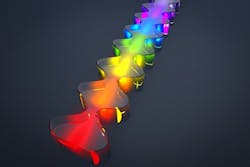Terahertz QCL produces evenly spaced frequency comb good for detecting explosives
Researchers from the Massachusetts Institute of technology (MIT; Cambridge, MA) Research Laboratory of Electronics and their colleagues have developed a new terahertz spectroscopy system containing a chip-scale quantum-cascade laser (QCL) that produces a frequency comb.1
The system can extract the spectroscopic signature of an organic material (such as an explosive or other chemical) in just 100 microseconds. In contrast traditional terahertz spectroscopic devices, which require a radiation source that's heavy and about the size of a large suitcase, take 15 to 30 minutes to analyze a single sample.
"With this work, we answer the question, 'What is the real application of QCL frequency combs?'" says Yang Yang, a graduate student in electrical engineering and computer science at MIT.
Different materials absorb different frequencies of terahertz radiation to different degrees, giving each of them a unique terahertz absorption profile. Traditionally, however, terahertz spectroscopy has required measuring a material's response to each frequency separately, a process that involves mechanically readjusting the spectroscopic apparatus. That's why the method has been so time consuming.
Because the frequencies in a frequency comb are evenly spaced, however, it is possible to mathematically reconstruct a material's absorption fingerprint from just a few measurements, without any mechanical adjustments.
Creating an even comb
The trick is evening out the spacing in the comb. The frequencies are dependent on the gain medium's refractive index -- and the refractive index varies for different frequencies, so the gaps between frequencies in the comb vary, too. To even out their lasers' frequencies, the MIT researchers and their colleagues use an oddly shaped gain medium with regular, symmetrical indentations in its sides that alter the medium’s refractive index and restore uniformity to the distribution of the emitted frequencies.
Yang; his advisor, Qing Hu, the Distinguished Professor in Electrical Engineering and Computer Science; and first author David Burghoff, who received his PhD in electrical engineering and computer science from MIT in 2014 and is now a research scientist in Hu’s group, reported this design in Nature Photonics in 2014. But while their first prototype demonstrated the design's feasibility, it in fact emitted two frequency combs, clustered around two different central frequencies, with a gap between them, which made it less than ideal for spectroscopy.
In the new work, Yang and Burghoff, who are joint first authors; Hu; Darren Hayton and Jian-Rong Gao of the Netherlands Institute for Space Research; and John Reno of Sandia National Laboratories developed a new gain medium that produces a single, unbroken frequency comb.
Like the previous gain medium, the new one consists of hundreds of alternating layers of gallium arsenide (GaAs) and aluminum gallium arsenide (AlGaAs) with different but precisely calibrated thicknesses.
Etalon serves as test object
As a proof of concept, the researchers used their system to measure the spectral signature of not a chemical sample but an optical etalon made from a wafer of gallium arsenide, whose spectral properties could be calculated theoretically in advance, providing a clear standard of comparison. The new system's measurements were a very good fit for the etalon's terahertz-transmission profile, suggesting that it could be useful for detecting chemicals.
Although terahertz QCLs are of chip scale, they need to be cooled to very low temperatures, so they require refrigerated housings that can be inconveniently bulky. Hu’s group continues to work on the design of increasingly high-temperature QCLs, but in the new paper, Yang and his colleagues demonstrated that they could extract a reliable spectroscopic signature from a target using only very short bursts of terahertz radiation.
"We used to consume 10 W, but my laser turns on only 1% of the time, which significantly reduces the refrigeration constraints," Yang says. "So we can use compact-sized cooling."
Source: http://news.mit.edu/2016/speedy-terahertz-based-system-could-detect-explosives-0520
REFERENCE:
1. Yang Yang et al., Optica (2016); doi: 10.1364/OPTICA.3.000499.

John Wallace | Senior Technical Editor (1998-2022)
John Wallace was with Laser Focus World for nearly 25 years, retiring in late June 2022. He obtained a bachelor's degree in mechanical engineering and physics at Rutgers University and a master's in optical engineering at the University of Rochester. Before becoming an editor, John worked as an engineer at RCA, Exxon, Eastman Kodak, and GCA Corporation.
